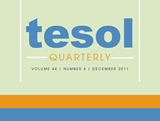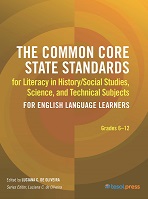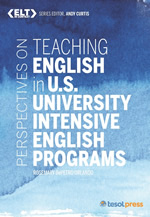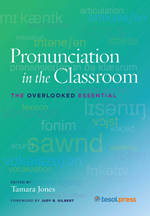Free TESOL Quarterly Article: "Second Language Comprehensibility Revisited: Investigating the Effects of Learner Background"
by Dustin Crowther, Pavel Trofimovich, Kazuya Saito, and Talia Isaacs
This article first appeared in TESOL Quarterly, Volume 49, Number 4, pgs. 814–837. Subscribers can access issues here. Only TESOL members may subscribe. To become a member of TESOL, please click here, and to purchase articles, please visit Wiley-Blackwell. © TESOL International Association.
|
Abstract
The current study investigated first language (L1) effects on listener judgment of comprehensibility and accentedness in second language (L2) speech. The participants were 45 university-level adult speakers of English from three L1 backgrounds (Chinese, Hindi, Farsi), performing a picture narrative task. Ten native English listeners used continuous sliding scales to evaluate the speakers' audio recordings for comprehensibility and accentedness as well as 10 linguistic variables drawn from the domains of pronunciation, fluency, lexis, grammar, and discourse. Comprehensibility was associated with several linguistic variables (segmentals, prosody, fluency, lexis, grammar), but accentedness was primarily linked to pronunciation (segmentals, word stress, intonation). The relative strength of these associations also varied as a function of the speakers' L1, especially for comprehensibility, with Chinese speakers influenced chiefly by pronunciation variables (segmental errors), Hindi speakers by lexicogrammar variables, and Farsi speakers showing no strong association with any linguistic variable. Results overall suggest that speakers' L1 plays an important role in listener judgments of L2 comprehensibility and that instructors aiming to promote L2 speakers' communicative success may need to expand their teaching targets beyond segmentals to include prosody-, fluency-, and lexicogrammar-based targets. |
With languages such as English, Spanish, Arabic, or Chinese becoming ever more prominent in international trade, education, and popular culture, particularly in communication among nonnative speakers, understanding various components of second language (L2) speaking ability emerges as an important goal for both language researchers and teachers. One key component of speaking ability is pronunciation, which has typically been discussed with reference to two broad constructs, namely, understanding and nativelikeness (see Derwing & Munro, 2009; Levis, 2005). Understanding embraces various aspects of speakers' ability to make themselves understood. Following common research and assessment practice, understanding is often measured as comprehensibility or listeners' perception of how easy or difficult it is for them to understand L2 speech, rated on 7- or 9-point scales. Nativelikeness, which broadly refers to speakers' ability to approximate speech patterns of the target-language community, is usually operationalized as a listener-based rating of accentedness, also using 7- or 9-point scales.
Although researchers have consistently underscored comprehensibility as a more realistic goal for ensuring communicative success, compared to accent reduction or nativelikeness (e.g., Derwing & Munro, 2009; Levis, 2005), there still remains a need to distinguish how various aspects of L2 speech (at the level of phonology, fluency, lexis, grammar, or discourse) feed into comprehensibility and how they impact accentedness. Previous research has shown that while accent is linked primarily to phonology- and fluency-based characteristics of L2 speech, comprehensibility is additionally linked to grammatical and lexical variables (e.g., Saito, Trofimovich, & Isaacs, 2014, in press; Trofimovich & Isaacs, 2012). However, despite the fact that several (if not most) theoretical perspectives in L2 pronunciation learning ascribe an important role to speakers' first language (L1) in determining the rate and ultimate success of learning (e.g., Eckman, 2004; Escudero & Boersma, 2004; Flege, 2003), previous research on comprehensibility and accent paid little attention to speakers' L1. In fact, most current evidence on L2 speech rating comes from studies that have either treated speakers of various L1s as a single group (e.g., Derwing, Munro, & Wiebe, 1998) or focused only on a single L1 group (e.g., Munro & Derwing, 1999). This limitation makes it unclear to what extent the linguistic variables that feed into comprehensibility and accentedness are specific to the speaker's L1. Therefore, the main objective of this study was to clarify the relationship between comprehensibility and accentedness, investigating the effect of speakers' L1 on listener perception of L2 comprehensibility and accentedness.
Disentangling Comprehensibility From Accent
For many L2 speakers and their teachers, the ideal ultimate learning goal is often to acquire the linguistic ability of a native speaker, characterized by native or near-native accent (Tokumoto & Shibata, 2011). However, adult L2 speakers rarely pass for native speakers (Bongaerts, van Summeren, Planken, & Schils, 1997), so accented L2 speech is generally seen as normal and often unavoidable, even for speakers who begin learning at an early age (Flege, Munro, & MacKay, 1995). Considering the difficulty of acquiring nativelike L2 speech, adopting a more realistic learning goal has been encouraged, with a particular focus on comprehensibility or ease of understanding (Derwing & Munro, 2009; Levis, 2005). Indeed, even a heavy L2 accent does not preclude speakers from being highly comprehensible (Munro & Derwing, 1999). A focus on comprehensibility also seems sensible from a practical perspective, given that the interlocutor's goal in most real-world contexts is to get his or her message across rather than to pass for a native speaker. Thus, to make informed decisions about future learning goals and to address these goals through instruction, L2 speakers and their teachers need to know which aspects of language contribute to comprehensible speech and which are tied to foreign accent.
This article first appeared in TESOL Quarterly, 49, 814–837. For permission to use text from this article, please go to Wiley-Blackwell and click on "Request Permissions" under "Article Tools."
doi: 10.1002/tesq.203
TC Monthly Giveaway Congratulations to Tara Arntsen, of Aberdeen, South Dakota, USA, for being the winner of the March 2016 TESOL Connections Monthly Giveaway. Tara won her choice of book from the TESOL Bookstore!
This month, TESOL is giving away
a free TESOL Quarterly subscription!

TESOL Quarterly (TQ), a refereed professional journal, fosters inquiry into English language teaching and learning by providing a forum for TESOL professionals to share their research findings and explore ideas and relationships in the field. TQ's readership includes ESOL teacher educators, teacher learners, researchers, applied linguists, and ESOL teachers.
Click here to enter
Drawing closes 25 April 2016, 11:59 pm EST
TESOL Blogs Interested in writing a blog for TESOL?
Read the submission guidelines and send us your post!
Check out the latest TESOL Blogs:
|
5 Tips for Enriched Vocabulary Presentation, by Robert Sheppard
 Even in integrated skills courses, we often have some kind of time dedicated expressly to vocabulary. Many of us approach it in a similar way: listing out words on the board, providing definitions and sample sentences for each. In this post I’ll present five easy ideas for enriching that board work and ensuring that this explicit vocabulary-focused time is as valuable as possible. Read More. Even in integrated skills courses, we often have some kind of time dedicated expressly to vocabulary. Many of us approach it in a similar way: listing out words on the board, providing definitions and sample sentences for each. In this post I’ll present five easy ideas for enriching that board work and ensuring that this explicit vocabulary-focused time is as valuable as possible. Read More.
|
|
Teaching English to Digital Natives: Common Computer Concerns for ELLs, by Nathan Hall
 Those of us who remember computers being a novelty in the classroom probably also remember being told how the new generation of students are “digital natives.” The assumption is that children who grow up surrounded by computers see nothing strange about using one for work or play, and would passively become experts with this technology. In practice, though, I’ve seen many students struggle to find specific information, evaluate the credibility of a webpage, or write comprehensible forum posts. Unless the teacher is aware of these deficits, those students will struggle with technology-related assignments. Read More. Those of us who remember computers being a novelty in the classroom probably also remember being told how the new generation of students are “digital natives.” The assumption is that children who grow up surrounded by computers see nothing strange about using one for work or play, and would passively become experts with this technology. In practice, though, I’ve seen many students struggle to find specific information, evaluate the credibility of a webpage, or write comprehensible forum posts. Unless the teacher is aware of these deficits, those students will struggle with technology-related assignments. Read More.
|
|
Great Grammar for TESOL Teachers, by Kristen Lindahl
 March 4th in the United States was National Grammar Day! To be honest, I would not have known it was was National Grammar Day had Facebook not reminded me. But still, the armchair grammarians of the world apparently celebrated; thus, this post is in honor of grammar and all who (mis)understand it. March 4th in the United States was National Grammar Day! To be honest, I would not have known it was was National Grammar Day had Facebook not reminded me. But still, the armchair grammarians of the world apparently celebrated; thus, this post is in honor of grammar and all who (mis)understand it.
Grammar is one of the most taught, most judged, and least understood concepts of language. Over hundreds of years, language teachers and textbook authors have attempted to reduce grammar to a digestible set of rules for students to remember and practice, only to realize that 1) the rules didn’t apply to every instance of use, and 2) the students didn’t really remember them anyway. Teachers can also be wary of grammar instruction, feeling less confident about teaching it than other aspects of language that seem more consistent and stable, such as vocabulary. Read More. |
|
5 Free Resources for Teaching Punctuation, by Elena Shvidko
 In today’s blog, I will describe five online resources that you can use to help your students learn more about the use of punctuation marks in their writing. In today’s blog, I will describe five online resources that you can use to help your students learn more about the use of punctuation marks in their writing.
1. Guide to Grammar and Writing
This resource can be useful for preparing your lessons on punctuation marks, as it provides detailed explanations with numerous examples. However, learners can also find this resource useful for their individual studies, because they can receive immediate feedback on the quizzes and practice activities included in the punctuation section.
Read More |
TESOL Bookstore

Featured Resources from TESOL Press
 CCSS for Literacy in History/Social Studies, Science, and Technical Studies for ELLs, Grades 6-12 CCSS for Literacy in History/Social Studies, Science, and Technical Studies for ELLs, Grades 6-12
Luciana de Oliveira, Editor
Learn specific pedagogical practices, strategies, and ideas for supporting ELLs as they meet the ambitious expectations of the CCSS.
 Teaching English in U.S. University Intensive English Programs Teaching English in U.S. University Intensive English Programs
Rosemary DePetro Orlando
This book sheds light on the ongoing challenges that face IEPs in U.S. universities, including the marginalization of IEPs in the university setting, as well as the lack of understanding of the unique needs of staff and students.
 Pronunciation in the Classroom: The Overlooked Essential Pronunciation in the Classroom: The Overlooked Essential
Tamara Jones, Editor
This indispensable handbook shows you how to incorporate pronunciation seamlessly into your lesson plans and explains the essential elements you need to know to help your students better communicate, no matter what subject you teach.
|
| ADVERTISEMENT |
 |
 |
|